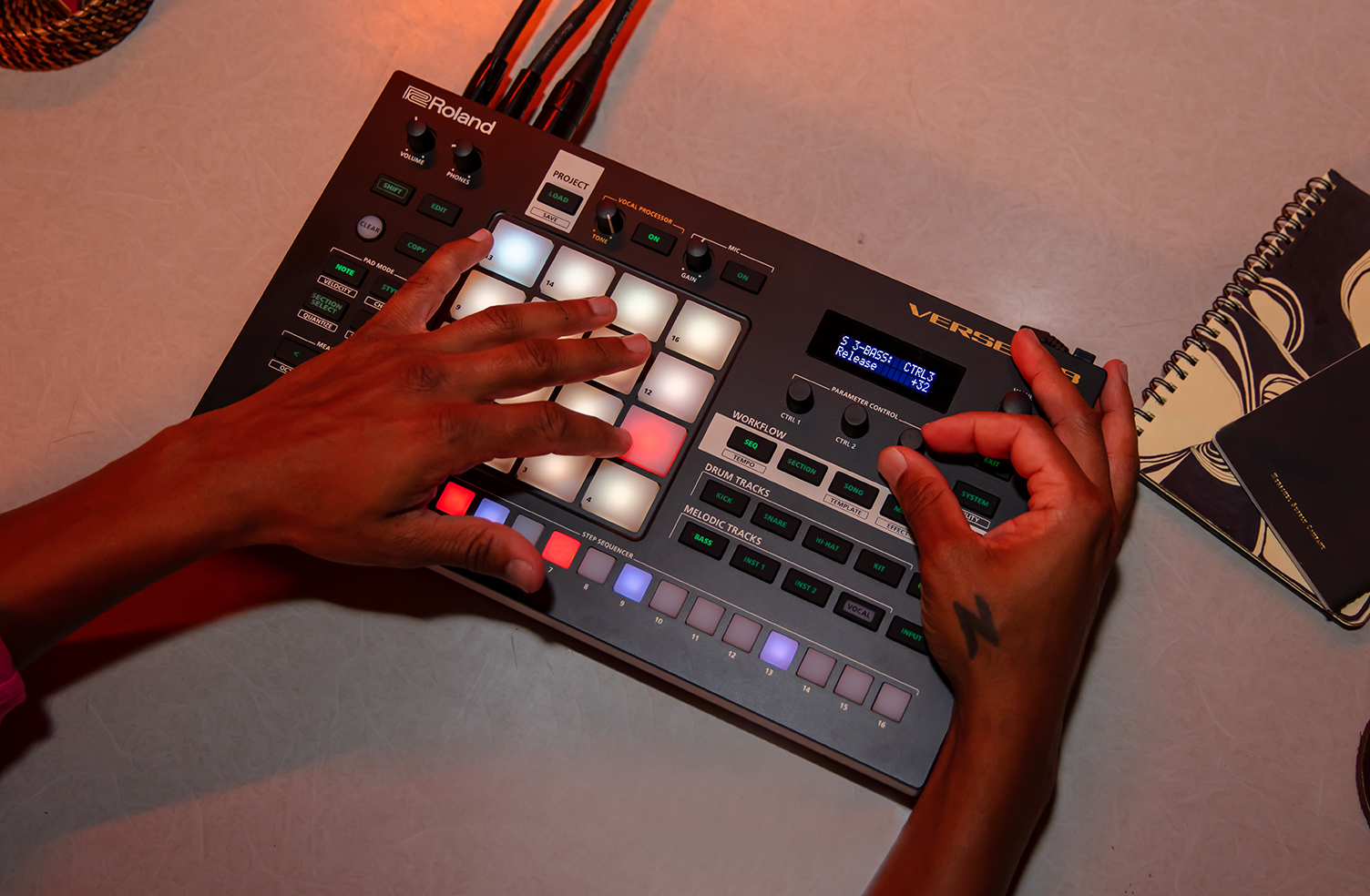Roland’s VERSELAB MV-1 arrived in January 2021 and has been a topic of conversation since its announcement. It’s an all-in-one production tool that provides a set of unique features for song creation. Songwriters can now complete full songs with just a single piece of hardware. ICON interviewed the Roland development team behind the instrument about the VERSELAB concept, its functions, and how they went directly to creators for production advice.
The Team Behind VERSELAB
An innovative production tool, VERSELAB lets producers create full songs with an immediacy that addresses the needs of modern artists. It features the ZEN-Core Synthesis System and 4×4 pads for live playing. Additionally, there’s a TR-REC-style step sequencer, high-quality mixing and mastering effects, and a USB audio/MIDI interface. We spoke with Development Product lead Shuichi Matsunaga, Global Marketing Manager Matthew Chicoine (AKA Recloose), and Matthew Presley, Development and Product Leader for Zenbeats to get the full story.
"We tried to listen to real voices and discover what kind of tools today's creators are looking for." -Shuichi Matsunaga

Connecting with Creators
ICON: VERSELAB is a new type of machine in that it focuses on songwriting with vocals. What can you tell us about its development?
Shuichi Matsunaga: To prepare for the project, I traveled all over the US with Matthew Chicoine and spoke with many creators. We tried to listen to real voices and discover what kind of tools today’s creators are looking for. At the same time, we discovered which points of existing machines they feel dissatisfied with. We formed several groups and interviewed them many times, especially the new generation of music creators.
Through the interviews, we learned people struggle to complete the songs. In essence, they wanted a machine for creating songs with vocals instead of merely making phrases.
Summing Up Feedback
Matthew Chicoine: Some people think if you want to make music, why not use a computer? That said, it can be very difficult to learn how to use a DAW or set up equipment. Many creators require a tool to make music quickly. When I heard that, I thought it was important to shorten the production process and directly connect ideas to goals.
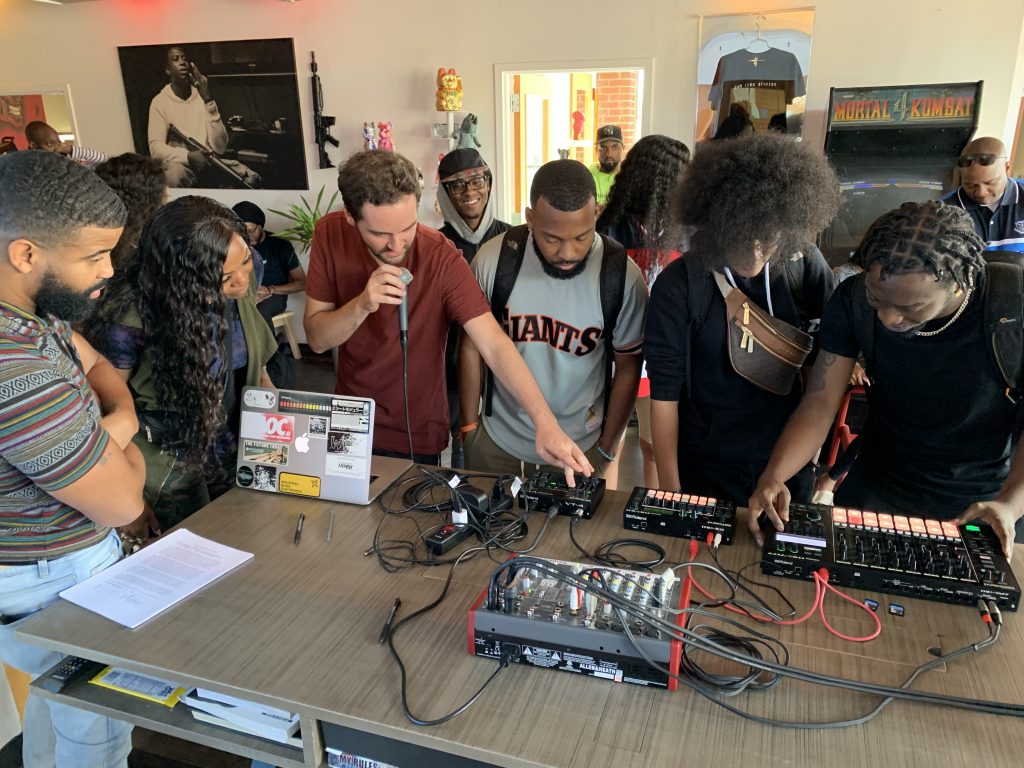
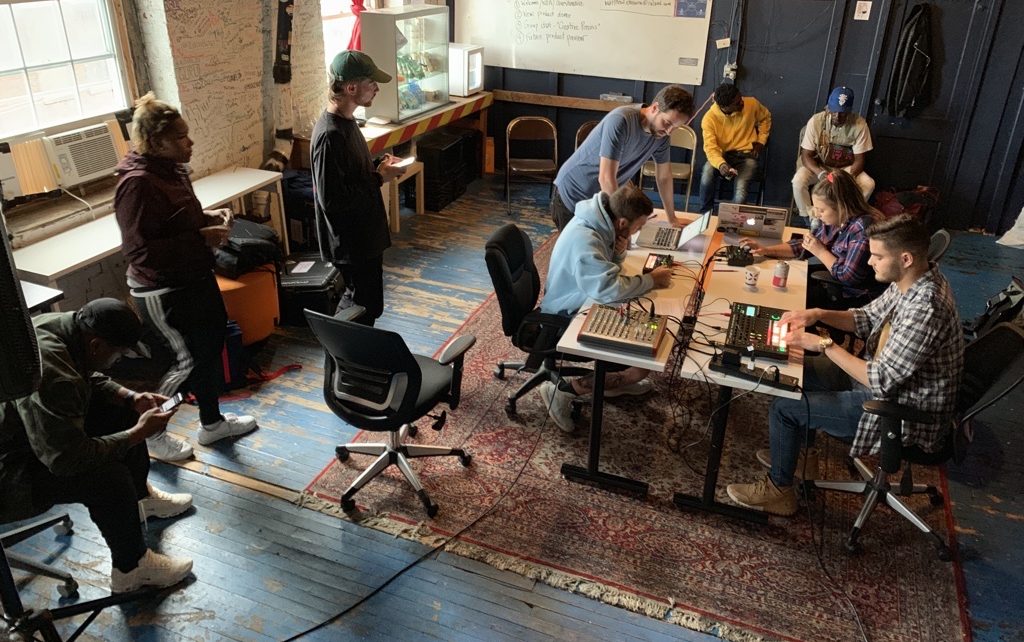
"We asked opinions from Q-Tip, Just Blaze, and Lord Finesse. The consensus was, it's going to be a very good machine for young creators." -Matthew Chicoine
SM: We summarized the creator’s stories and came up with the idea of a machine focusing on production to make pop and hip-hop easily. The project began two years ago. Our plan was to develop a machine, not for phrases or rhythms, but to create complete songs with vocals.
MC: After putting our thoughts together, we asked opinions from producers like Q-Tip, Just Blaze, and Lord Finesse. They all spoke highly of it. The consensus was, it’s going to be a very good machine for young creators. At that point, we knew this would succeed.
How VERSELAB is Different
Is VERSELAB MV-1 a new AIRA product?
SM: No, the development members are the same. It’s a different concept from what AIRA creates. AIRA instruments focus on live performance more than production. They can switch phrases but aren’t designed for constructing songs. In contrast, VERSELAB has songwriting features for complete music production without relying on a DAW.
VERSELAB has both 4×4 pads and TR-REC-style step sequencers. How does it work?
SM: The VERSELAB is an all-in-one production tool that helps everyone make music. Compared to existing machines, the big feature is the VOCAL track for recording direct vocals. This means you can make entire songs with vocals using just VERSELAB. It’s also equipped with the ZEN-Core Synthesis System. This includes 128 simultaneous sounds and more than 3,000 kinds of sounds for various styles. In addition, you can download more tones from Roland Cloud.
Users can have up to seven tracks, and you can create phrases with 4×4 pads and the TR-REC-style step sequencer. High-quality mixing and mastering effects come pre-loaded. So does the USB audio and MIDI interface to connect to a computer, tablet, or smartphone. In short, VERSELAB helps to make a complete song from ideas that pop into a user’s head.

Tracking Down a Vibe
Are seven tracks enough?
SM: The total number is eight including the VOCAL track. We decided on that number based on the fundamental number of tracks needed to create a song. It’s not too difficult to increase the tracks. The more you have, the more things you can do, but you can also complicate the structure of a song.
It may seem odd to choose so few tracks, but kick drum, snare drum, hi-hat cymbals, bass, melodies, and vocals are enough to create music. I like to check out the charts. I’ve noticed the structures of songs are getting simpler. With that in mind, listening to the VERSELAB demo, no one has felt there were too few tracks.
MC: Even in modern pop and hip-hop, few songs have more than seven tracks of accompaniment. For us, making a song quickly was an important concept. As a result, we reduced the number of tracks. We created specifications for complete songs by intentionally reducing options.
Instrument of Construction
Instruments come pre-assigned to 7 tracks of accompaniments. For example, KICK/SNARE/HI-HAT for drums and BASS, as well as INST 1 and INST 2 for instruments playing scales.
SM: This is so users can start making songs immediately after switching on the machine. Each track has a button, so you can select them and program phrases.
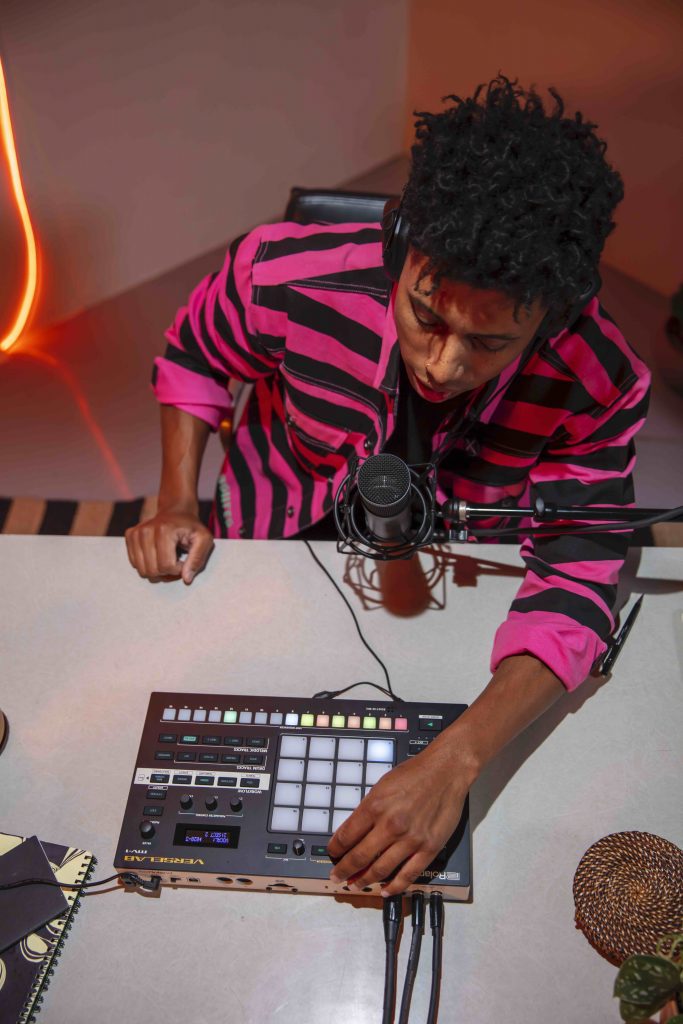
"VERSELAB incorporates lots of functions to improve the speed of creation."
-Matthew Chicoine
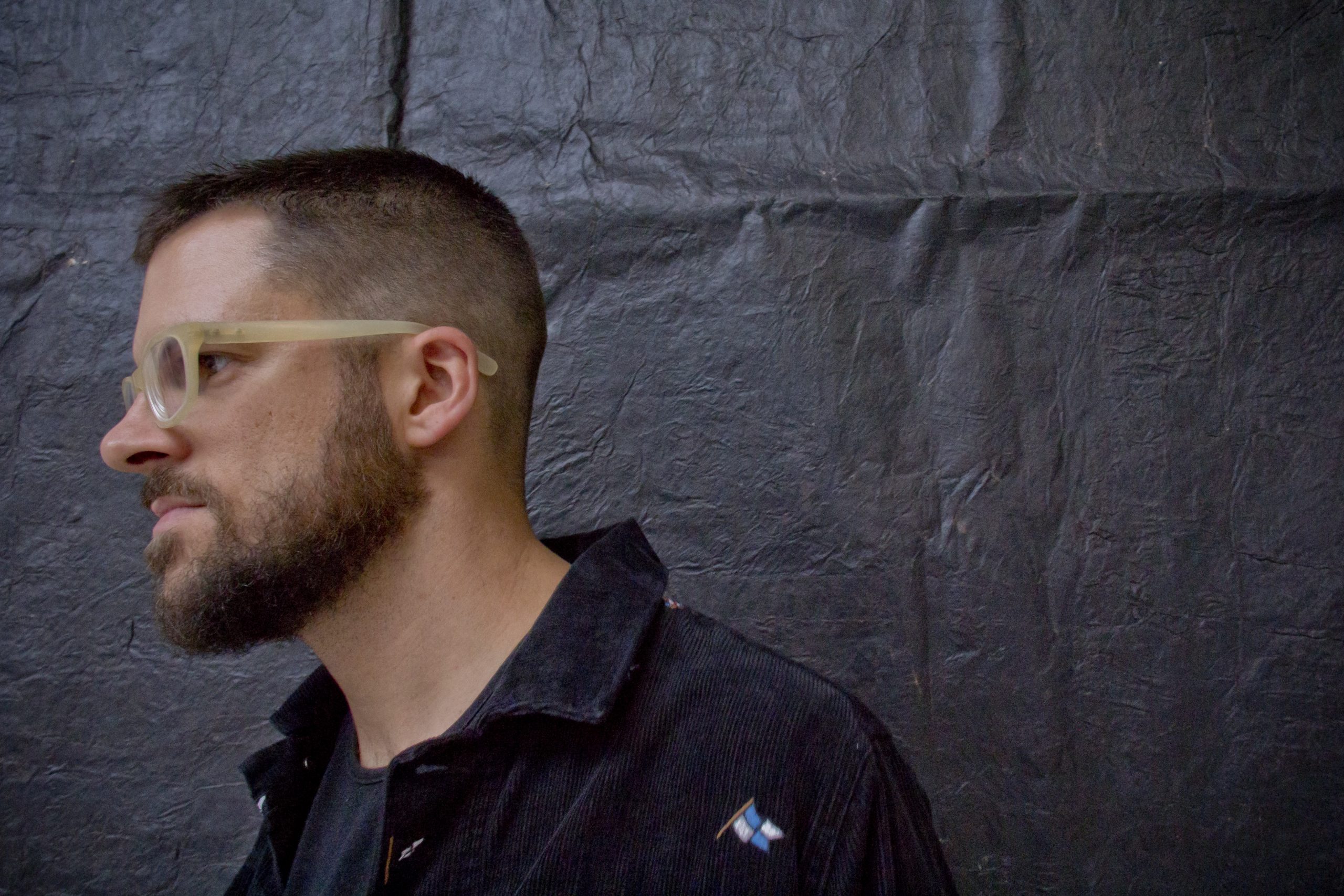
Are these assignments fixed?
SM: No, users can set them. There are three kinds of tracks: Tone to play scales, Drum Kit to play the drums, and Looper to play sampled sounds. You can also set all seven tracks to Tone.
A Box That’s Out of the Box
It seems you designed VERSELAB for a box-style experience, instead of a keyboard-style one.
MC: We decided on this style from the beginning. We didn’t consider built-in keyboards because young creators don’t use them as much. They prefer 4×4 pads to input phrases. Some of them don’t even use pads, just a mouse and keyboard.
SM: VERSELAB is a little smaller than the MC-707 (W 358mm × D 208mm × H 60mm). From the beginning, we wanted to make it portable enough to carry. We settled on this size through trial and error. It was crucial to make the buttons as big as possible while keeping the unit small enough to carry in a bag. It doesn’t take batteries. However, you can connect a mobile battery to a USB port if there’s no outlet.
VERSELAB is unique that it has both 4×4 pads and a TR-REC-style step sequencer.
MC: Overall, our main target users of VERSELAB are hip-hop and pop music creators and they prefer the 4×4 pad style. We added a TR-REC-style step sequencer because it is also a vital tool. The step sequencer was initially designed for the TR-808. Eventually, through DAW software and synthesizers, it’s grown into a popular tool.
Vocalists, Please Apply
Please tell us about the VOCAL track, a prominent VERSELAB feature.
SM: As the name suggests, the VOCAL track is an exclusive track to record and play vocals and raps. Connect a microphone into an XLR input or use the onboard microphone to record vocals.
MC: In our interviews, we learned many young people start with vocals, not by building tracks. These trends taught us that creators want to express themselves in this way. Also, some of them don’t own a microphone so we decided to include a built-in one.
SM: The XLR input works with phantom power. This means users can connect a condenser microphone. They can record vocals in 16 takes—the same as the number of pads. These follow the song’s timeline. You can then store the data on onboard memory and save up to ten minutes total. This is enough for a typical song. Plus, you can overdub, use sampled sounds in the song, or include an SD card as a vocal take.
Editing and Effects
Can you edit vocal takes?
SM: It’s possible to set the attack time, loop time, and volume of each vocal take. Also, you can play vocal takes on 4×4 pads and add sequenced patterns with different timing.
MC: It’s also important to note the VOCAL track has an onboard vocal processor.
SM: VERSELAB has seven kinds of vocal processing effects. These are Noise Suppressor, Enhancer, Compressor, DeEsser, Equalizer, Pitch Correction, and Harmony. The functions let you correct mistakes and make harmonies. You can use them not only when playing, but also when recording. For example, you can record vocals with pitch correction.
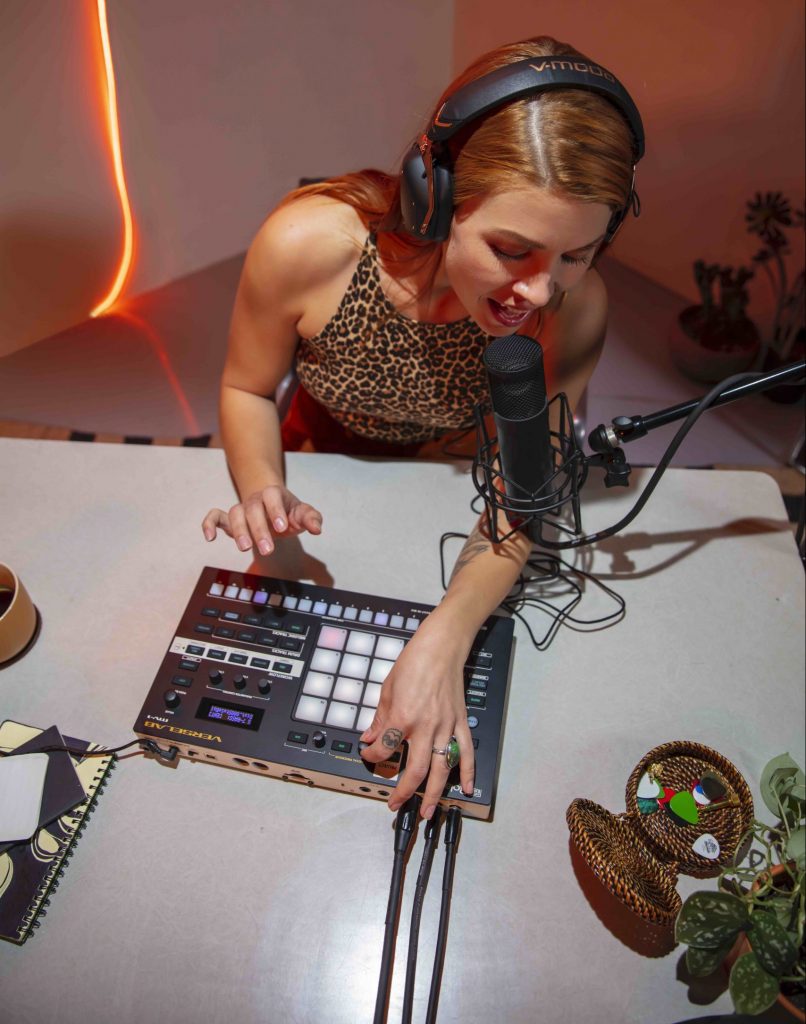

"For half a century, Roland has developed various sound sources. The ZEN-Core Synthesis System lets us use them as hardware or software." -Syuichi Matsunaga
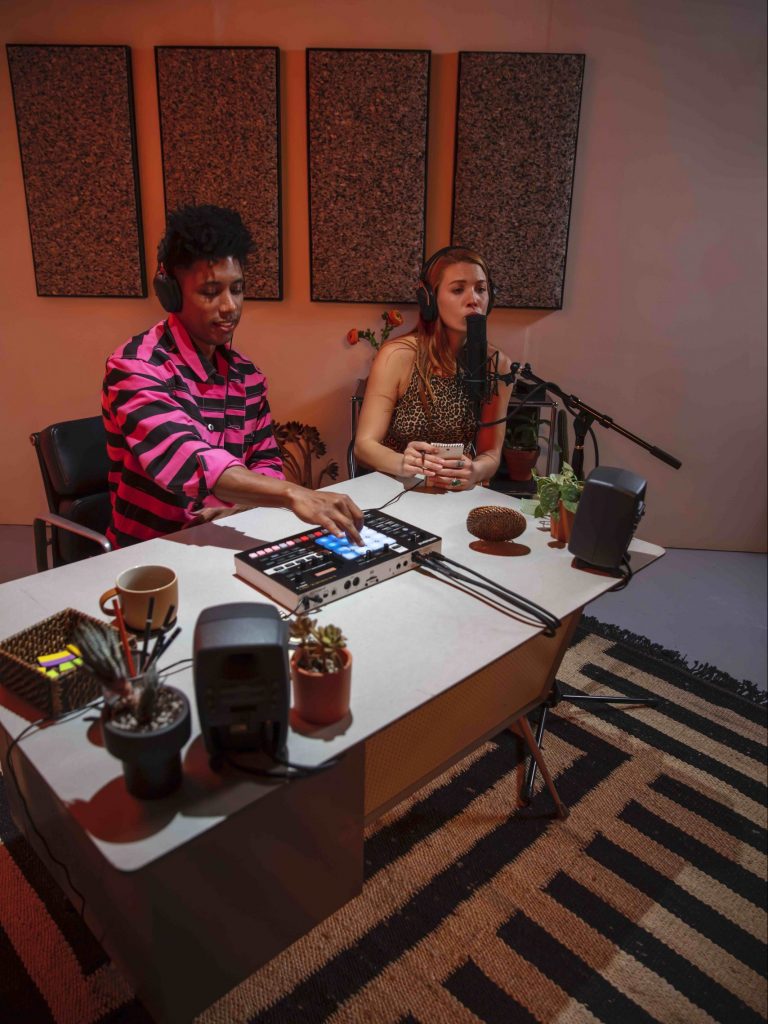
Special Functions
VERSELAB is a machine for complete music creation. Did you include any special functions to achieve that goal?
SM: There are some special functions. For example, we prepared Note to play scales, Velocity to input 16 stages of velocity, and Section Select to select sections by pressing pads. Style and Chord mode are also useful. Styles are for programming triplet, rolls, arpeggio. Codes allow for programming optional codes. Users can set up arpeggio and codes to their specifications.
MC: Another useful function in VERSELAB is SONG MODE. If you’re able to make a few measures of a pattern, you can make music. However, in SONG MODE, you can experiment with different pre-set song templates.
Get Into SONG MODE
It seems useful to be able to change templates later.
MC: We learned from interviews that artists don’t have much time to spend on a single song. They need to finish a ton of songs in a week. As a result, both song quality, and creation speed are very important. VERSELAB incorporates lots of functions to improve the speed of song creation. Of these, the most useful is SONG MODE, a unique function not common in software DAWs.
Songwriting = Workflow
Tell us about the WORKFLOW buttons above the track buttons.
SM: In VERSELAB, we call the songwriting process WORKFLOW. It’s divided into 5 steps. SEQ is for inputting/editing the phrases of each track. SECTION is for grouping tracks except for vocals. SONG is for completing the song by arranging sections.
Finally, MIXER is to mix down and MIXDOWN is for mastering and writing the song to file. With these, creators can follow the steps to mixing and mastering by pushing a button.
ZEN-Core to the Core
What is the ZEN-Core Synthesis System featured in VERSELAB?
SM: For half a century, Roland has developed various sound sources. These include Analog, PCM, Analog modeling, etc. The ZEN-Core Synthesis System lets us use these sound sources as hardware or software. It’s not just a sound source—more like a “sound platform.”

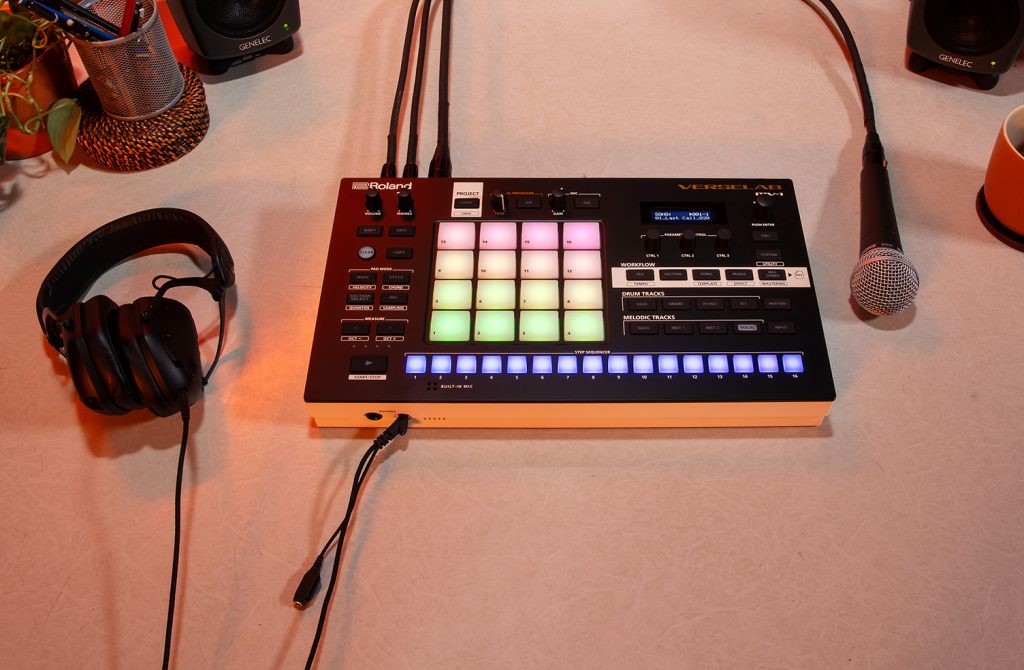
"By connecting Zenbeats, VERSELAB expands its screen and tracks, while keeping its key functions." -Matthew Presley

What kind of use do you expect for the USB audio/MIDI interface functions?
SM: It will integrate with Roland’s music creation app Zenbeats in the upcoming update. Mr. Matthew Presley, a member of the Zenbeats development team describes this.
Zenbeats and VERSELAB
Matthew Presley: Zenbeats for desktop, tablet, smartphone, and VERSELAB are completely integrated via USB connection. This gives users access and control of multiple VERSELAB workflows on any screen. You can easily edit and arrange clips and sections via drag and drop. Plus, you can also edit each clip’s synth, MFX, and mix settings just by double-tapping on the clip itself.
The Mixer workflow includes fast access to your instrument tracks key mixing features as well as plugins for built-in EQ, compressors, and mastering effects. Lastly, we provide quick shortcuts to capture multitrack stems (Windows and Mac only). This allows users to bounce your entire project into Zenbeats and continue to add more tracks and instruments if desired.
"No matter how many functions we add, we maintain the concept of simple, accessible, and cool music software." -Matthew Presley

Overall, the most important thing is that we maintain the simple workflow of VERSELAB. By connecting Zenbeats, VERSELAB expands its screen and tracks, while keeping its key functions.
MC: I like the small screen of VERSELAB because I can concentrate on the work. But to be honest, the bigger Zenbeats screen is useful for elaborate mixing. On the other hand, when you collaborate with other creators, the linking function with Zenbeats is useful. By pairing VERSELAB and Zenbeats, there are many different possible workflows. Ultimately, it all depends on the user.
Whoever, Wherever, and on Whatever
What are some advantages of Zenbeats compared to other DAWs?
MP: We don’t consider Zenbeats a DAW. There are a lot of excellent DAWs in the world. We never want to compete against them. So, what is Zenbeats? We think of it simply for music creation and appreciation. Zenbeats aims to be software to make cool music easily and simply for whoever, wherever, and on whatever platform. Zenbeats is multi-platform, compatible with Mac, Windows, iOS, and Android.
MC: I’m also involved in the education market. Most US educators want to help children experience the joy of music. To that end, they want to teach using modern music more than a traditional approach like playing piano. However, often there are only Chromebooks and iPad at school, so they can’t use a computer for education. You can use Zenbeats on a Chromebook without problems, and the user interface is accessible. Overall, it’s the best solution for use in schools. (Note: Zenbeats only works on Chrome OS supporting Android apps.)
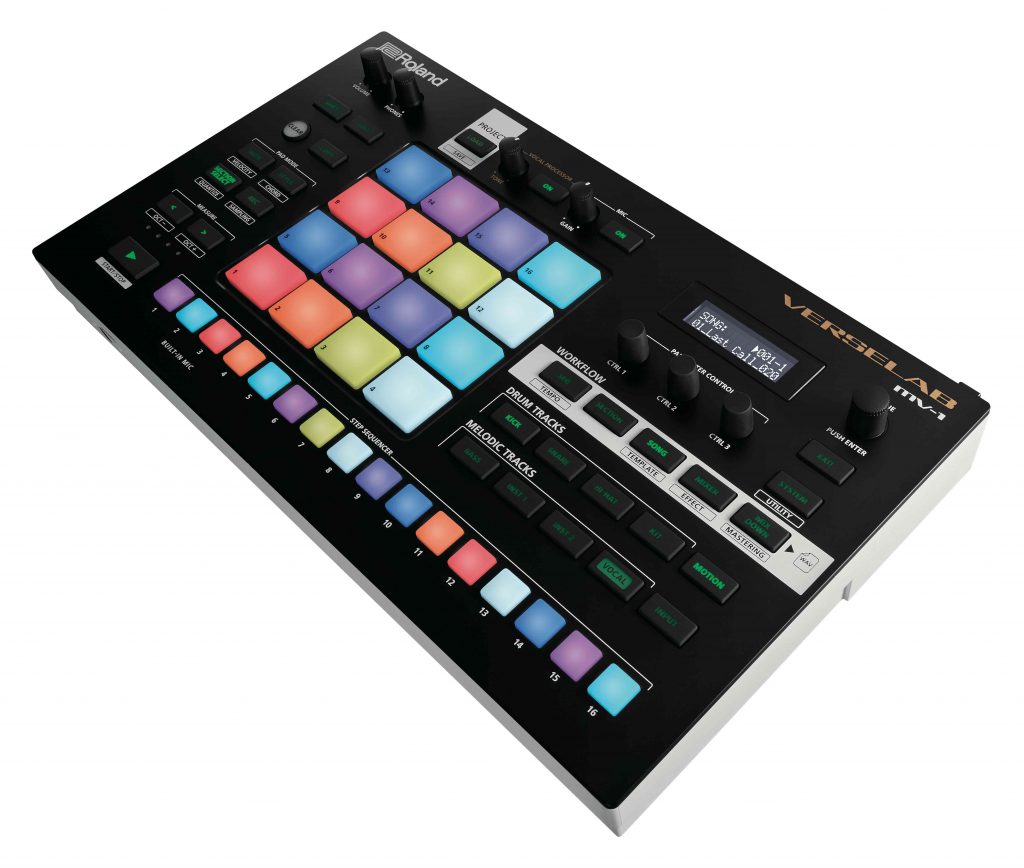
MP: Last autumn, with Zenbeats 2.0, we added the software sound source, ZC1. ZC1 includes the ZEN-Core Synthesis System and runs on iOS and Android as well as Mac and Windows. It’s very meaningful for young people who downloaded the free Zenbeats app on smartphones to experience real Roland sounds.
You said Zenbeats is not a DAW. How do you approach development?
MP: We don’t add new functions one after another like other DAWs. Of course, we listen to user demands and opinions and include necessary functions. Still, no matter how many we add, we maintain the concept of simple, accessible, and cool music software.
A New Look
The VERSELAB look is also different from previous machines, down to its white side color.
MC: Many young creators asked us to give its look a unique characteristic, something different than all-black. Instead, we designed the sides to be white, to differentiate it from previous machines.

Why did you keep the screen small compared to other current machines?
SM: We dared ourselves to do it. When there’s a screen, the information can bother the user and creation becomes work. We like to think of VERSELAB as a machine to make music without relying on visual information.
What’s in a Name?
Tell us about the origin of the name of VERSELAB?
MC: I named it by crossing VERSE, meaning the section in the song, with LAB from laboratory. The word “verse” is an iconic term in the hip-hop community as well beinig a song section. We added “lab” to emphasize how the machine brings out the user’s creativity through experimentation.
Development Challenges
What was the hardest point of development?
SM: It was difficult to figure out how to simplify creating a song. When developing a machine like this, we always consider adding functions. But if we include too many functions, it stops being user-friendly. It was challenging to make the machine as simple as possible while incorporating functions for production. If we’d shown people prototype one, they’d say, “Add more functions.” Our faith in our vision had to remain strong.
MC: We had more conversations between Roland US and Japan than ever before. Mr. Matsunaga and I worked together for DJ-808 and DJ-202, so communication has been good, but it was sometimes challenging to integrate feedback from the larger group settings due to the language barrier.


"The arrangement process can be challenging in a DAW. It's powerful to see the mood of a song change so effortlessly."
-Matthew Chicoine
Where to Begin?
Finally, what would you like to tell users who try out VERSELAB after reading this article?
SM: Listen to the demo songs and you’ll be surprised to discover you can make these sounds with just VERSELAB. After buying it, start creating in SONG MODE using your favorite demo song.
MC: I make songs as a DJ/producer, and for me, the arrangement process can be challenging in a DAW. By using VERSELAB, you can easily try various arrangements in SONG MODE. It’s powerful to see the mood of a song change so effortlessly.
